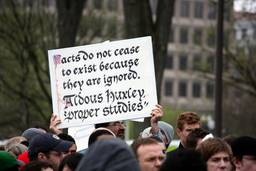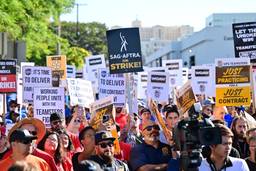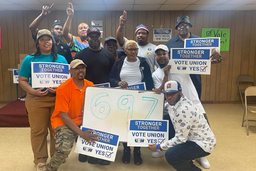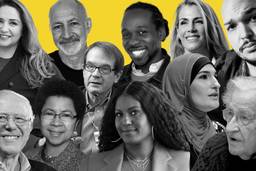John D. Rockefeller gave out dimes to little kids to burnish his image, helping launch the modern PR industry. Andrew Carnegie started a foundation after looting his way to the top with his industrial monopolies. Now Goldman Sachs, after helping wreck the economy by pumping up the subprime maket and then swindling investors, says, in the words of CEO Lloyd Blankfein, “I apologize.” It’s giving away $500 million to assist and train leaders of small businesses.
In fact, this bogus business assistance stunt is especially cruel because Goldman Sachs’s market maninpulations helped spur the credit crisis that’s now crushing small businesses and helped cause over 10% in unemployment — while requiring yet another stimulus to salvage the economy Goldman Sachs nearly destroyed.
Indeed, the $500 million is just chump change for Goldman Sachs executives, who are on track to receive over $20 billion in bonuses and added pay this year.
As William Greider examined the hypocrisy at work in a recent Nation column:
Rockefeller became a living symbol of miserly indifference. Nor will Lloyd Blankfein, CEO of Goldman Sachs, win much public affection for his charitable capitalism.
Goldman and the other big dogs of Wall Street are afflicted with the stink of greed, having harvested swollen fortunes from the calamity they caused for the rest of the country. Blankfein made it worse by recently telling a British interviewer that, when you consider all the good things Goldman Sachs does for the economy, “we’re doing God’s work.” God evidently rewards such good works up-front. Goldman executives expect to collect more than $20 billion in bonuses at year’s end. The rest of the economy is still waiting for its reward.
To soften the sting, Blankfein announced the firm will devote $500 million to assist small businesses, either as loans or grants to help the little guys learn better managerial skills. More to the point, Blankfein spoke the words that financial titans have avoided. “I apologize.” The firm, he acknowledged, did some bad stuff, though he did not say what. “We participated in things that were clearly wrong and have reason to regret.” Maybe federal investigators should subpoena Blankfein, put him under oath and demand the details.
Wall Street is belatedly responding to its public relations problem. But this is really a political problem because public anger is gathering force and focus and scaring the bejeesus out of Washington pols.
SEIU has a beter idea how Goldman Sachs can use the money. As it pointed out in an alert this week:
Yesterday, Lloyd Blankfein said he’s committed to job creation. He should tell that to the 150 Stella D’Oro workers in New York who lost their jobs when Goldman Sachs took over their company. The workers, whose tax dollars bailed out Goldman, tried to meet with Lloyd Blankfein in September. They wanted to tell him the harm he was doing to their struggling community.
He didn’t listen. Maybe we can get his attention. Will you call Goldman Sachs and ask them to use the tax dollars we gave them to help the workers at Stella D’Oro?
The Stella D’Oro story is all too familiar. It’s just one of many family-owned businesses sucked up by Goldman Sachs, loaded down with massive debt, and forced to either declare bankruptcy or lay off their workers to survive.
We gave Goldman Sachs $63 billion of our tax dollars so they could clean up the economic mess they created. But they’ve only made it worse. Tell Lloyd Blankfein to stop with the PR stunts and start helping Stella D’Oro workers and all the small businesses his company has hurt.
But this program also helps burnish the image of Goldman Sachs by allying the rapacious firm with the folksy billionaire Sage from Ohama. As Buffett told the New York Times:
In an interview, Mr. Buffett said he was approached by Goldman to take part in the effort “last month or so.” He said he was not committing any money of his own but would provide “advice from the 35,000-foot level.”
“I would not be doing this if I didn’t think there was going to be a significant net benefit to small-business owners in this country,” Mr. Buffett said, adding that he was not disturbed by Goldman’s image problems and defended its hefty profits. “They are making a lot of money now,” he said. “I am all for it and this program is a beneficiary.”
But there’s also another beneficiary: lovable Buffett poured in $5 billion to save Goldman Sachs during the meltdown and is now reaping the rewards.
As the Times reported in July:
Warren E. Buffett showed again why he is known as one of the world’s best investors, thanks in part to another prominent investor, Goldman Sachs.
Mr. Buffett’s stake in Goldman is now worth $9.1 billion, or about $4.1 billion more than what he paid 10 months ago, according to an analysis by Linus Wilson, an assistant professor of finance at the University of Louisiana at Lafayette.
According to Mr. Wilson’s calculations, Mr. Buffett would realize an annualized return of 111 percent if he sold his Goldman stake, which is held by his conglomerate Berkshire Hathaway.
In comparison, the federal government received a 23 percent annualized return for its Goldman investment.
Goldman turned to Mr. Buffett in September, seeking a cash injection. In return, Mr. Buffett negotiated what was considered even then to be very favorable terms.
Sam Gustin at Daily Finance explains how the program is supposed to work – and the mutual back-scatching involved in the charitable deal:
In Tuesday’s announcement, Goldman Sachs said it has pledged to the small business project just over 3% – $500 million – of what it hopes to pay its bankers and traders in bonuses this year…
Through the 10,000 Small Businesses project, Goldman Sachs will contribute $200 million in educational grants and offer “practical business education delivered through partnerships between local community colleges, universities and other institutions…”
Goldman will also participate in a “mentoring and networking” program with “national and local” partners. And it will invest $300 million “through a combination of lending and philanthropic support” to “small businesses in underserved communities.”
Vague Mea Culpa
In a savvy move, the bank – known on Wall Street as “Goldmine Sachs” for its prodigious money-making – has teamed up with Buffett, the world’s most famous investor and the model of patient, long-term value investing – which has the veneer of more virtue than the high-volume digital speed-trading that now characterizes so much of finance.
Buffett also happens to be Goldman’s largest investor, so it’s in his interest to improve the public image of the bank, which has endured a slew of negative publicity in the wake of the financial collapse and ensuing recession.
John D. Rockefeller, no doubt, would be proud that today’s CEOs have built on his earlier PR image-building so well.






